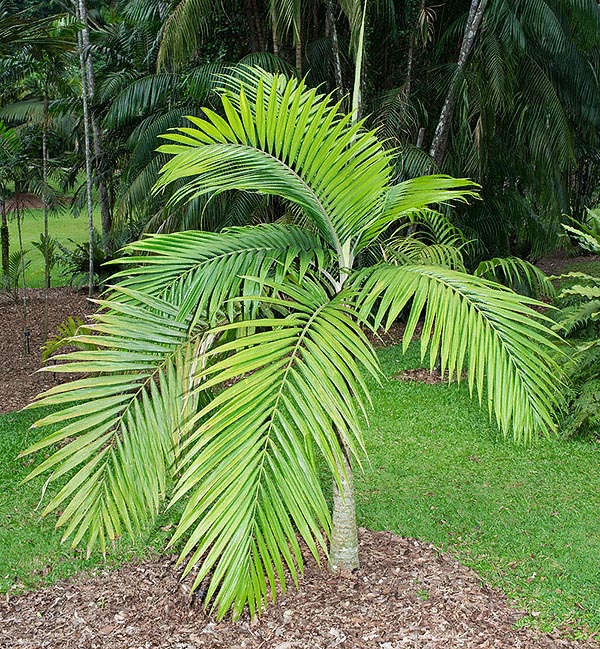Family : Arecaceae

Text © Pietro Puccio

English translation by Mario Beltramini

At extinction risk in nature, Burretiokentia hapala in New Caledonia can be 15 m tall © Giuseppe Mazza
The generic term is the combination of the name of the German botanist Max Burret (1883-1964), to whom the palms were one of the main interests, and of the genus Kentia; the specific name comes from the Greek adjective “ἁπαλός” (hapalos) = morbid, with reference to the tomentum that covers the inflorescences.
The Burretiokentia hapala H.E.Moore (1969) is a monoecious species, unarmed, up to 15 m tall, with single stem, of 10-16 cm of diameter, of bright green colour, except in the oldest part, on which stand out the whitish rings trace of the fallen leaves.
The leaves, on a 5-15 cm long petiole, are pinnate, 2-2,4 m long, with oblong pinnules having long pointed apex arranged regularly along the rachis on a same level, in the median part 70-90 cm long and 3-5 cm broad, of intense green colour, coriaceous and glossy above.
The foliar base, dark green and covered by a dense and thin pale brown to whitish tomentum, wraps wholly the stem for a height of 0,6-1 m, forming a sort of tubular capital lightly swollen at the base.
Inflorescences, on a short peduncle, under the leaves (infrafoliar), with ramifications of the first order, initially erect then drooping, 40-50 cm long, covered by thick pale brown tomentum, bearing unisexual flowers arranged in triads (a female flower between two male ones), proterandrous (the male flower ripes before the female ones, this favours the crossed fecundation).
Ovoid fruits with pointed apex, about 1,5 cm long and of 0,8 cm of diameter, initially green, then reddish when ripe, containing one seed only with irregular surface.
It reproduces by seed, previously kept in water for one day, in organic draining loam maintained humid at the temperature of 26-28 °C, with germination times of 2-4 months.

Much ornamental, with 2-2,4 m leaves, is a palm born for the tropical gardens, but can resist, for short time, to -2 °C © Giuseppe Mazza
The species is inserted in the red list of the IUCN (International Union for theConservation of Nature) as “vulnerable” (species at risk of extinction in nature).
→ For general notions about ARECACEAE please click here.
